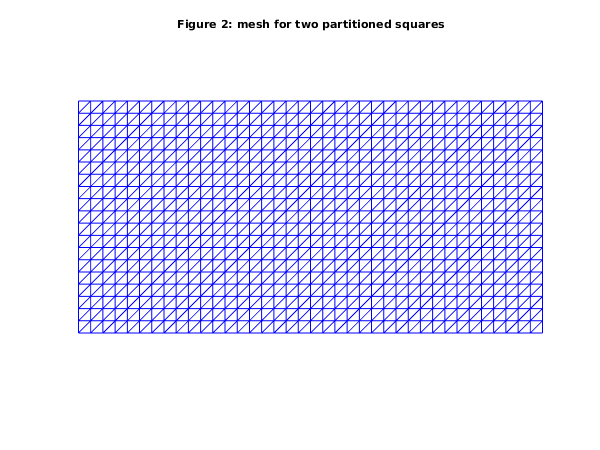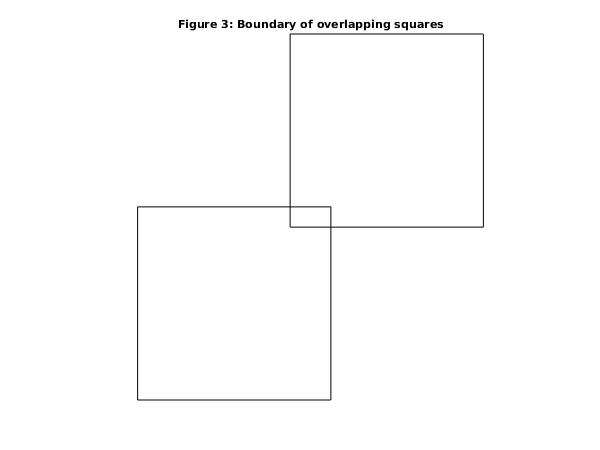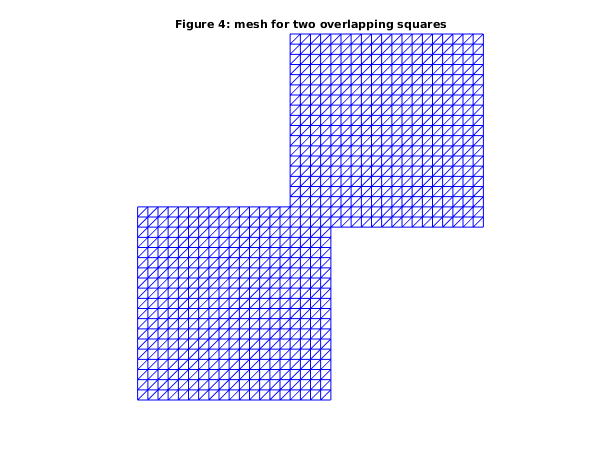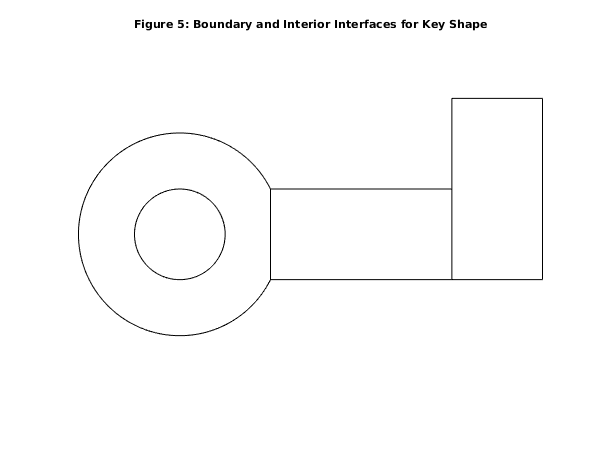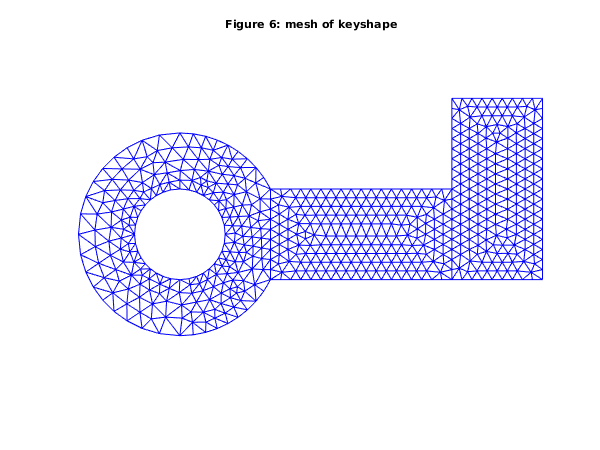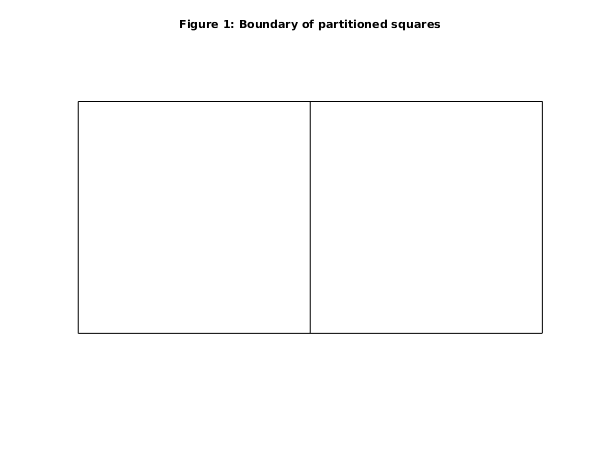
| (i) | if the th edge is part of the partition interface, then will contain the value where and are the tags for the same edge of the first and the second mesh respectively; |
| (ii) | otherwise, will contain the same tag as the corresponding edge belonging to the first and/or the second input mesh. |
| On entry, | , |
| or | , |
| or | , |
| or | , |
| or | or for some and , |
| or | for some , |
| or | or for some and , |
| or | or or for some , |
| or | , |
| or | , |
| or | , |
| or | or for some and , |
| or | for some , |
| or | or for some and , |
| or | or or for some , |
| or | . |
| (a) | overlapping meshes (, ), |
| (b) | partitioned meshes (, ). |
Open in the MATLAB editor: d06db_example
function d06db_example fprintf('d06db example results\n\n'); d06db_ex1; d06db_ex2; function d06db_ex1 fprintf('Example 1\n\n'); n = 20; coor1 = zeros(2,n^2); dx = [0:1/(n-1):1]; for j = 1:n coor1(1,(j-1)*n+1:j*n) = dx; coor1(2,(j-1)*n+1:j*n) = dx(j); end edge1 = ones(3, 4*n-4, 'int64'); ind = int64(1:n-1); edge1(1, 1:(4*n-4)) = [ind,n*ind,n^2+1-ind,n^2+1-n*ind]; edge1(2, 1:(4*n-5)) = edge1(1, 2:(4*n-4)); edge1(2, 4*n-4) = edge1(1, 1); conn1 = zeros(3, 2*(n-1)^2, 'int64'); k = 0; l = int64(0); for i=1:n-1 for j=1:n-1 l = l + 1; k = k + 1; conn1(1, k) = l; conn1(2, k) = l + 1; conn1(3, k) = l + n + 1; k = k + 1; conn1(1, k) = l; conn1(2, k) = l + n + 1; conn1(3, k) = l + n; end l = l + 1; end reft1 = ones(2*(n-1)^2, 1, 'int64'); reft2 = reft1; reft2(:) = int64(2); itype = [int64(1)]; itrace = int64(1); for ktrans = 1:2 if ktrans==2 % Transform the first domain to obtain an overlapping second domain a = (n-5)/(n-1); b = (n-3)/(n-1); trans = [a; b; 0; 0; 0; 0]; % plot boundary for partitioned geometry fig3 = figure; plot([0 1 1 0 0], [0 0 1 1 0], 'black', ... [a a+1 a+1 a a],[b b b+1 b+1 b],'black') axis off axis equal title('Figure 3: Boundary of overlapping squares'); fig4 = figure; else % Domains partition trans = [1; 0; 0; 0; 0; 0]; % plot boundary for partitioned geometry fig1 = figure; plot([0 2 2 0 0],[0 0 1 1 0],'black',[1 1],[0, 1],'black') axis off axis equal title('Figure 1: Boundary of partitioned squares'); fig2 = figure; end [coor1, edge1, conn1, coor2, edge2, conn2, ifail] = ... d06da( ... itype, trans, coor1, edge1, conn1, itrace); % Restitch the meshes [nv3, nelt3, nedge3, coor3, edge3, conn3, reft3, ifail] = ... d06db( ... coor1, edge1, conn1, reft1, coor2, edge2, conn2, reft2, itrace); % Plot the result triplot(transpose(double(conn3(:,1:nelt3))), coor3(1,:), coor3(2,:)); axis equal; axis off; if ktrans==2 title ('Figure 4: mesh for two overlapping squares'); else title ('Figure 2: mesh for two partitioned squares'); end end function d06db_ex2 fprintf('\n\nExample 2\n\n'); % First Geometry % ----------------------------------------------------------- nlines = 9; % Characteristic points of the boundary mesh coorch = [ 2 2 1 -1 -2.2361 0.0000 0 0 0.0000; -1 1 0 0 0.0000 -2.2361 -1 1 2.2361]; % Lines of the boundary mesh n10 = int64(10); line = [n10 10 10 10 10 10 10 10 10; 1 2 9 5 6 3 8 4 7; 2 9 5 6 1 8 4 7 3; 0 2 2 2 2 1 1 1 1]; rate = ones(nlines,1); % number of connected components ncomp = 2; nlcomp = int64([5; -4]); lcomp = ones(nlines,1,'int64'); lcomp(1:nlcomp(1)) = [1 2 3 4 5]; lcomp(nlcomp(1)+1:nlines) = [9 8 7 6]; % Generate boundary mesh nvmax = int64(700); nedmx = int64(200); itrace = int64(0); crus = [0; 0]; [nvb1, coor1, nedge1, edge1, user, ifail] = ... d06ba( ... coorch, line, @fbnd, crus, rate, nlcomp, lcomp, nvmax, ... nedmx, itrace); % Generate mesh using Delaunay-Voronoi method weight = []; npropa = int64(1); [nv1, nelt1, coor1, conn1, ifail] = ... d06ab( ... nvb1, edge1, coor1, weight, npropa, itrace, 'nedge', nedge1); % Smooth numfix = int64([0]); nqint = int64(0); [coor1, ifail] = d06ca( ... coor1, edge1, conn1, numfix, itrace, nqint, ... 'nv', nv1, 'nelt', nelt1, 'nedge', nedge1, ... 'nvfix', int64(0)); % Second Geometry % ----------------------------------------------------------- nlines = 4; % Characteristic points of the boundary mesh coorch = [ 2 6 6 2; -1 -1 1 1]; % Lines of the boundary mesh n19 = int64(19); line = [n19 10 19 10; 1 2 3 4; 2 3 4 1; 0 0 0 0]; rate = ones(nlines,1); % number of connected components ncomp = 1; nlcomp = [int64(4)]; lcomp = int64([1 2 3 4]); % Generate boundary mesh [nvb2, coor2, nedge2, edge2, user, ifail] = ... d06ba( ... coorch, line, @fbnd, crus, rate, nlcomp, lcomp, nvmax, ... nedmx, itrace); % Generate mesh using Advancing Front method [nv2, nelt2, coor2, conn2, ifail] = ... d06ac( ... nvb2, edge2, coor2, weight, itrace, 'nedge', nedge2); % Third Geometry (rotation and translation of second) % ----------------------------------------------------------- itype = [int64(3)]; trans = [6; -1; -90; 0; 0; 0]; [coor3, edge3, conn3, coor3, edge3, conn3, ifail] = ... d06da( ... itype, trans, coor2, edge2, conn2, itrace, 'nv', nv2, ... 'nelt', nelt2, 'nedge', nedge2); % ----------------------------------------------------------- % Combine 3 meshes % ----------------------------------------------------------- % Restitch 1 and 2 to form mesh 4 reft1(1:nelt1) = int64(1); reft2(1:nelt2) = int64(2); [nv4, nelt4, nedge4, coor4, edge4, conn4, reft4, ifail] = ... d06db( ... coor1, edge1, conn1, reft1, coor2, edge2, conn2, reft2, itrace, ... 'nv1', nv1, 'nelt1', nelt1, 'nedge1', nedge1, ... 'nv2', nv2, 'nelt2', nelt2, 'nedge2', nedge2); % Restitch 3 and 4 to form mesh 5 reft3(1:nelt2) = int64(3); [nv5, nelt5, nedge5, coor5, edge5, conn5, reft5, ifail] = ... d06db( ... coor4, edge4, conn4, reft4, coor3, edge3, conn3, reft3, itrace, ... 'nv1', nv4, 'nelt1', nelt4, 'nedge1', nedge4, ... 'nv2', nv2, 'nelt2', nelt2, 'nedge2', nedge2); fprintf(' The restitched mesh characteristics\n'); fprintf(' nv = %5d\n', nv5); fprintf(' nelt = %5d\n', nelt5); fprintf(' nedge = %5d\n', nedge5); % Plot boundary fig5 = figure; a = asin(1/sqrt(5)); t1 = linspace(a, 2*pi-a, 100); t2 = linspace(0, 2*pi, 100); hold on r = sqrt(5); plot(r*cos(t1),r*sin(t1),'black'); r = 1; plot(r*cos(t2),r*sin(t2),'black'); plot([2 6 6 2 2],[-1 -1 1 1 -1],'black'); plot([6 8 8 6 6],[-1 -1 3 3 -1],'black'); axis off axis equal title('Figure 5: Boundary and Interior Interfaces for Key Shape'); % Plot mesh fig6 = figure; triplot(transpose(double(conn5(:,1:nelt5))), coor5(1,:), coor5(2,:)); axis equal; axis off; title ('Figure 6: mesh of keyshape'); function [result, user] = fbnd(i, x, y, user) result = 0; if (i == 1) % inner circle result = x^2 + y^2 - 1; elseif (i == 2) % outer circle result = x^2 + y^2 - 5; end
d06db example results
Example 1
Transformation 1: translation
translation vector: 1.000 0.000
Final transformation matrix y = A*x + b:
1.000 0.000 1.000
0.000 1.000 0.000
Transformation 1: translation
translation vector: 0.7895 0.8947
Final transformation matrix y = A*x + b:
1.000 0.000 0.7895
0.000 1.000 0.8947
Example 2
The restitched mesh characteristics
nv = 643
nelt = 1133
nedge = 171

